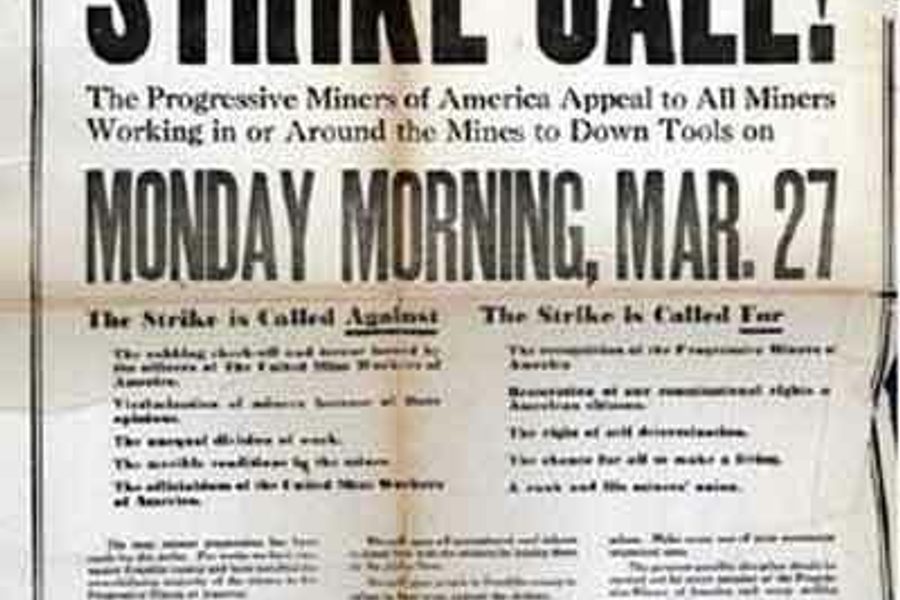
The brutal battles fought by union miners in Appalachia are legendary.
But Illinois artist and labor historian Greg Boozell has found that Illinois miners and their descendants are mostly unaware of the landmark mine wars fought in their own state — wars not only fought with mine owners, but between union members themselves.
Widely revered (and reviled) former United Mine Workers of America President John L. Lewis, founder of the Congress of Industrial Organizations, was from Midwestern mining country. Lewis was first elected to local UMWA leadership in Panama, Ill.
He is known for a long career fighting for better wages and working conditions for miners, but he opposed socialist trends in the labor movement. In the early 1930s he spearheaded attacks in Illinois on a breakaway section of the UMWA, known as the Progressive Miners of America (PMA) — hence the Mine Wars that left towns bitterly divided and people murdered.
Boozell chronicles this largely forgotten history at MineWar.org and in a forthcoming documentary, No Backward Step: The Struggle for Democracy in the Illinois Coal Fields.
He describes the split as happening after Lewis “usurped a wage referendum and imposed a company-supported contract on workers,” with the PMA forming “in order to reclaim the rights of rank and file miners and reject Lewis’ autocracy.”
The interactive (and still under construction) website catalogues important dates in the struggle, including various murders and the institution of the Mother Jones monument in Mt. Olive, Ill., which was actually commissioned by the PMA and erected despite Lewis’ attempt to halt it. There is also the unusual story of PMA and UMWA miners cooperating to secure the 1939 release of young men imprisoned for the accidental death of a girl during the mine war; PMA miners were later kicked out of their union because of the effort.
An interactive Google map marks, with photos, text and video, the sites of former mines and key marches and other events in the mine wars. Calm and banal photos of rural street corners belie the dramatic history, like the site of the Peabody mine in Kincaid, Ill., where PMA auxiliary member Emma Cumerlato was killed in 1933.
Other tidbits include:
On August 24, 1932 miners from central Illinois assemble to march in what some called “the greatest delegation in the history of organized labor.” Staunton was chosen in part because of its symbolic importance. In 1897, miners marched from here to Springfield to win Governor Tanner’s support during a strike. And as was the case in 1932, the 1897 strike continued in defiance of the international union.
And:
Handbills urging union miners…to cease work and meet members of the army of miners from central and northern Illinois were dropped from an airplane over the coal fields and towns of Franklin county Thursday morning. The text of the handbills: Miners of southern Illinois: All out today. Meet your 25,000 union brothers at the Franklin county line. They have come to aid you to put an end to the gunman rule and terrorism which is being used to force you to work under a wage scale you have twice rejected. The miners of the whole district are with you. Down your tools today.
The site also features directions to Lewis’ grave in Springfield, Ill., a largely-ignored monument that Boozell visited with a retired UMWA member.
As legislators, energy officials and environmentalists debate the future of coal in our nation’s economy, Boozell’s is a fascinating look back, along with current context including the contemporary “war” over mountaintop removal coal mining. He sums it up with a quote from troubadour Steve Earle: “There is no such thing as clean coal … coal at the very least has blood on it.”
Kari Lydersen is a Chicago-based journalist, author and assistant professor at Northwestern University, where she leads the investigative specialization at the Medill School of Journalism, Media, Integrated Marketing Communications. Her books include Mayor 1%: Rahm Emanuel and the Rise of Chicago’s 99%.








